Notes from Tinctoria Gardens, Oklahoma, Spring 2011
By Heather Clark Hilliard
No scientific hypothesis could have summed up the surprises I experienced last year when planting my first dye garden. Beginning with the seeds, I documented the unfolding stages of germination, seedling, bud-to-bloom, maturity, harvesting, and seed saving. I also documented some bugs and diseases. These efforts helped me narrow my tinctoria garden planting choices, and to recognize which plants are the healthiest and most productive in my growing climate. What will grow here successfully in a dye garden? Let me share the surprises and a few of the unanticipated delights.
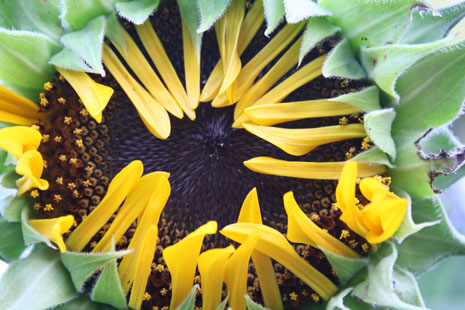
There were a handful of tinctoria garden woes. Hollyhock (Alcea rosea) Dahlia hybrids, and Calendula officinalis, are all best reserved for pretty bouquets, as they do not grow well enough in Oklahoma to be prolific. Woad (Isatis tinctoria) and Weld (Reseda luteola) started strong, but were quickly susceptible to the clay garden soil and heat. I also started woad seeds in a sandy loam garden in another location, on the off chance of their gaining a foothold. These biennials are known to be tough, yet even they withered in the heat. Early this Spring, however, I discovered a few surviving, healthy plants that I suspect went dormant through the summer heat. Once the temperatures cooled, they resumed their growth cycle and are now flowering!
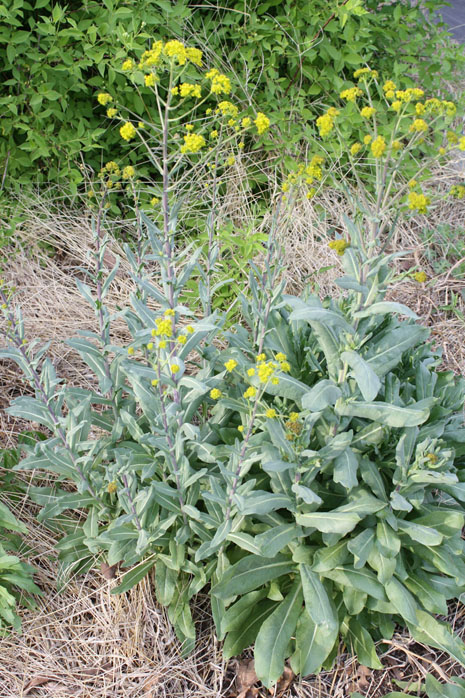
As wild sunflowers grow all over the state, I presumed the Hopi Black Dye Sunflower, a specific helianthus strain, would have no trouble in Oklahoma. Although one Hopi sunflower managed to reach almost twelve feet high, they all suffered from one bug invasion after another. It was a bad year for sunflowers. I am going to give them another chance this season.
| Sunflower invaded by caterpillars | Sunflower eaten by insects |
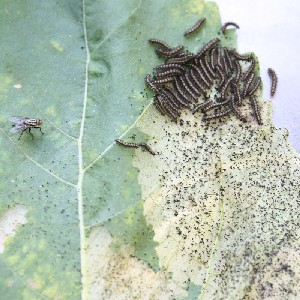 |
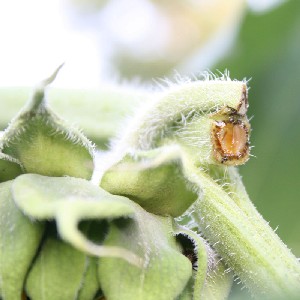 |
| Photograph Copyright by Heather Clark Hilliard | Photograph Copyright by Heather Clark Hilliard |
Of the eleven dye plant species I planted, five are maintaining their stronghold positions in my tinctoria gardens. Coreopsis grandiflora has been well established in my garden, and, this year I am starting Coreopsis tinctoria. Also known as "Dyer's coreopsis," this plant is notable for the unusual orange color it imparts to cotton. Although they are small and delicate, they are one of the most resilient wildflowers grown in central Oklahoma.
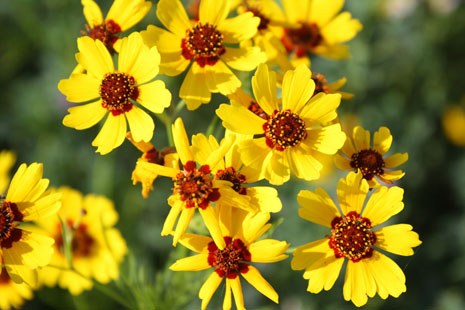
Last spring I was not able to find tansy seed (Tanacetum vulgare) early enough to plant, but did manage to transplant two of these lovely perennials, which have adapted well to their new home. The entire top of the plant can be used for dyeing.
| Tansy and flowering madder | Bed of madder |
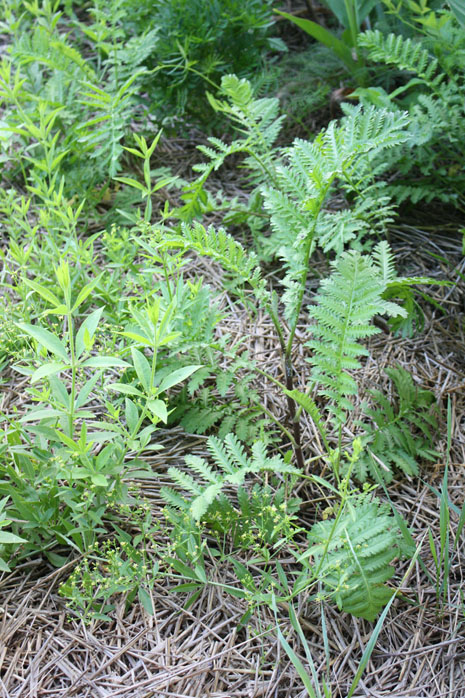 |
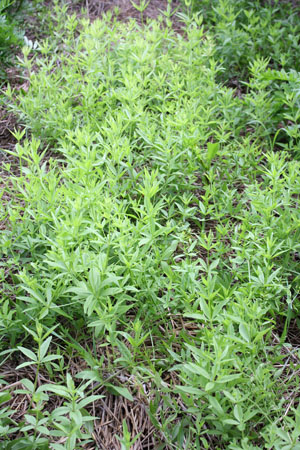 |
| Photograph Copyright by Heather Clark Hilliard | Photograph Copyright by Heather Clark Hilliard |
I have grown madder (Rubia tinctoria) in the past, so I was confident it would survive our Oklahoma climate. This reliable perennial poked up its head through the mulch early this spring, and is already a foot tall. It surprised me by making seed during its first growing season; I found this to be unusual for a perennial. Having planted my saved seed, I am patiently waiting for the germination results. Hopefully, my madder bed will be larger this year. The clay soil is alkaline, the soil pH madder prefers.
By October, I was practically begging the French marigolds (Tagetes patula)—workhorse of the garden—to please stop producing. While waiting for the first frost in early November, I had trouble keeping up with the harvest. With only about a dozen and a half plants, the flower harvest exceeded 13 pounds!
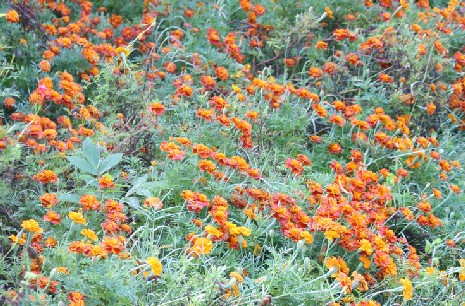
The most delightful surprise of all was that Japanese Indigo (Polygonum tinctorium) loves Oklahoma. In awe, and in honor of Japan, this plant will always find a spot in my tinctoria garden. It is lush and beautiful, and determined to thrive. I harvested seed and left the plants in the ground for the frost and the cycle of winter. In April I found small Japanese indigo seedlings volunteering in my garden. Though I was concerned about the pollination of the seeds, I am happy to report their viability and abundant germination. Although there was some leaf curling during early summer, this was remedied by more frequent watering and a thick layer of mulch to help retain soil moisture. Typically Oklahoma is hot and humid, but the dry air brought by this year's drought will likely present additional challenges during the growing season.
| Japanese Indigo flowers | Mature Japanese Indigo plants |
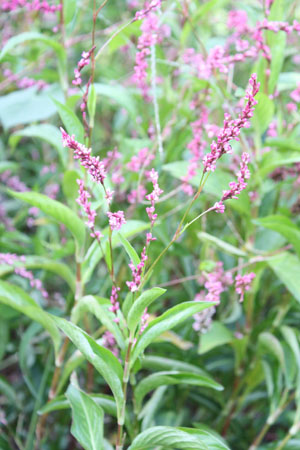 |
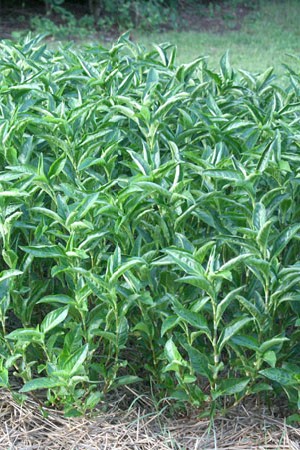 |
| Photograph Copyright by Heather Clark Hilliard | Photograph Copyright by Heather Clark Hilliard |
Finally, there are three other plants that produce beautiful hues and make attractive and unusual textures in the garden: Mullein (Verbascum species), Goldenrod (Solidago species), and Rudbeckia, or Black Eyed Susan. These varieties are all hardy options that can either be cultivated or collected locally.
The world's different growing regions are experiencing rapid climate changes, and in many cases, the results are extreme. With barely any precipitation since November 2010, my home in central Oklahoma is plagued by a severe drought. We are facing a challenging summer with water rationing on the horizon. As temperatures rise, if the clouds continue to withhold their moisture, my 2011 tinctoria garden plans will need to be to be narrowed. It is important to cultivate those dye plants with tenacious growing habits, for the resource-efficient production of dye materials for my artisan dye pots. Many of the seeds I am planting this year are ones saved from last year's garden; these include Japanese Indigo, Hopi black dye sunflower, French marigold, and madder.
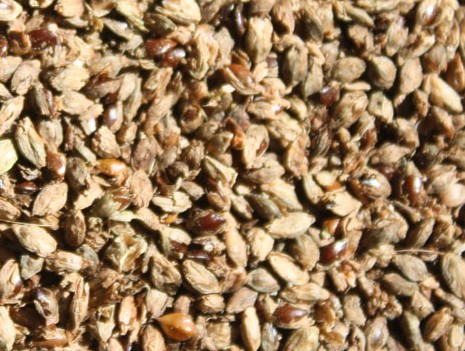
 Turkey Red Journal
Turkey Red Journal
